The world of fragrance is built on sensory experiences, where every detail matters—from the first visual impression of a bottle to the final lingering notes on the skin. Yet one of the most critical components often goes unnoticed by consumers: the perfume pump. This seemingly simple mechanism serves as the gateway between your carefully crafted fragrance and the end user, making the difference between a premium experience and a frustrating disappointment.
Consider this: you’ve invested thousands of dollars in developing the perfect fragrance blend, designed an elegant bottle, and crafted compelling marketing materials. But if your pump fails to deliver consistent spray patterns, leaks precious fragrance, or breaks after minimal use, all that investment crumbles. The pump isn’t just a functional component—it’s a critical touchpoint that influences brand perception, customer satisfaction, and ultimately, your bottom line.
The Challenge: Navigating Complex Pump Selection Options
The challenge facing both manufacturers and consumers today is navigating the complex landscape of perfume pump options. With three primary attachment methods dominating the market—crimp-on, screw-on, and snap-on—each offering distinct advantages and limitations, making the right choice requires understanding technical specifications, cost implications, user experience factors, and long-term strategic considerations.
This blog will demystify the world of perfume pumps, providing you with the knowledge needed to make informed decisions whether you’re a fragrance manufacturer, brand manager, or simply a curious consumer wanting to understand what makes some perfumes perform better than others. We’ll explore the intricate details of each pump type, analyze their performance characteristics, examine real-world applications, and provide a practical framework for selection.
By the end of this article, you’ll understand how pump selection impacts everything from production costs to customer loyalty, enabling you to align your choices with your specific needs, budget, and brand positioning. Whether you’re launching a luxury fragrance line or developing a mass-market product, the insights here will help you avoid costly mistakes and optimize your fragrance delivery system for maximum impact.
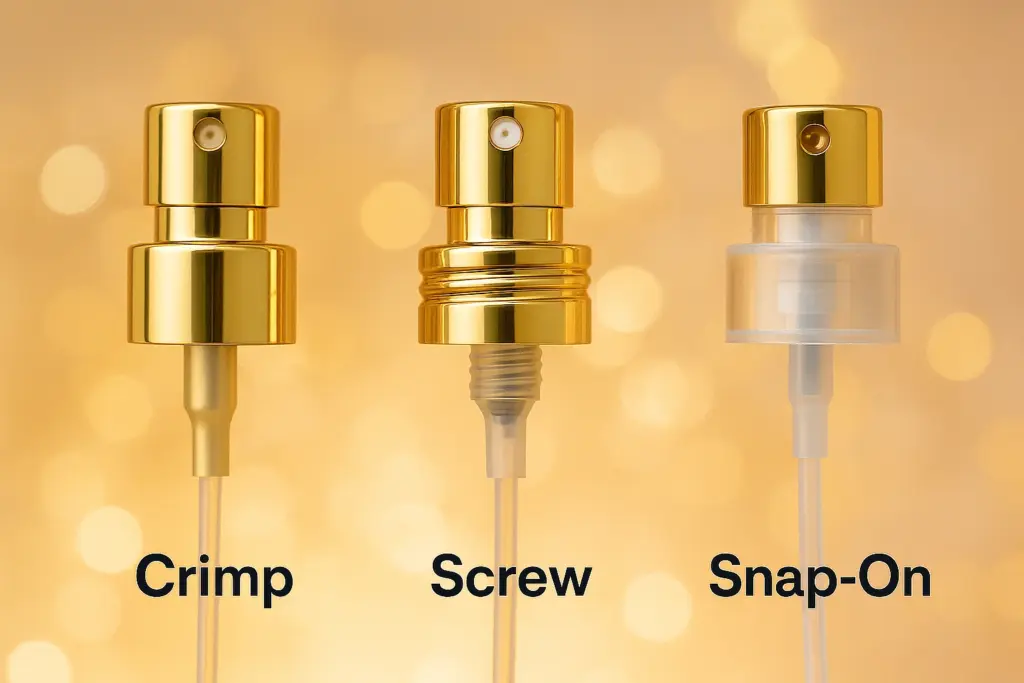
Understanding Perfume Pump Basics
The Anatomy of a Perfume Pump
Before diving into the specifics of different attachment methods, it’s essential to understand what a perfume pump actually is and why it plays such a crucial role in the fragrance experience. At its core, a perfume pump is a precision-engineered dispensing system designed to transform liquid fragrance into a fine mist of consistent droplets, delivering the perfect amount of product with each actuation.
The anatomy of a perfume pump consists of several critical components working in harmony. The actuator serves as the user interface—the button or lever that users press to dispense fragrance. Below this sits the pump housing, which contains the mechanical heart of the system: springs, valves, and chambers that create the pressure differential necessary for spray formation. The stem extends down into the fragrance, while the dip tube reaches to the bottle’s bottom, ensuring product can be dispensed until the container is nearly empty.
Performance Requirements and Engineering Consistency
This seemingly simple mechanism must perform a remarkable feat of engineering consistency. Each pump stroke must deliver a precise volume of fragrance—typically between 0.1 to 0.15 milliliters—while creating uniform droplet sizes that optimize fragrance distribution and longevity on the skin. The spray pattern must be consistent, avoiding both weak dribbles and harsh, uneven bursts that waste product or create an unpleasant application experience.
Brand Impact and Customer Experience
Why does pump selection matter so significantly? The impact extends far beyond basic functionality. From a user experience perspective, the pump directly influences how customers perceive your brand. A smooth, consistent pump operation signals quality and attention to detail, while a sticky, uneven, or leaky pump immediately undermines brand credibility. Luxury consumers, in particular, expect flawless performance that matches their premium investment.
Product Integrity and Quality Preservation
Product integrity represents another critical consideration. Fragrance is a volatile, sensitive medium that can deteriorate when exposed to air, contaminants, or inconsistent dispensing mechanisms. A properly selected pump helps preserve fragrance quality throughout the product’s lifecycle, maintaining the intended scent profile and preventing premature degradation that could lead to customer complaints or returns.
Cost Implications Beyond Initial Investment
Cost implications extend beyond the initial pump price. Poor pump selection can result in excessive product waste, increased return rates, customer service costs, and damaged brand reputation—expenses that far exceed any savings from choosing cheaper components. Conversely, the right pump choice can enhance brand perception, reduce operational headaches, and create competitive advantages that justify premium pricing.
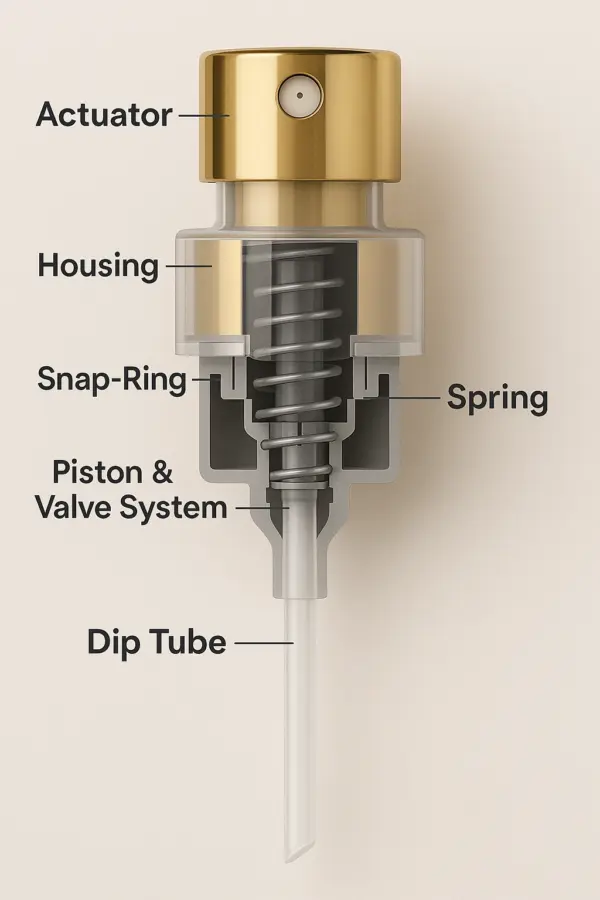
Crimp-On Pumps: The Hallmark of Luxury Security
Crimp-on pumps represent the most permanent and secure attachment method in the fragrance industry, utilizing mechanical compression to create an irreversible bond between pump and bottle. This attachment method involves placing the pump onto the bottle neck and using specialized crimping equipment to deform a metal sleeve or collar, creating a tight, tamper-proof seal that cannot be removed without destroying the pump or bottle neck.
The technical specifications of crimp-on systems center around precise mechanical tolerances and materials engineering. The crimping process requires exact pressure application to achieve optimal seal integrity without over-compression that could damage the bottle or under-compression that might allow leakage. Most crimp-on pumps utilize aluminum or plastic collars with specific hardness ratings designed to deform predictably under controlled pressure, creating consistent results across production runs.
Manufacturing Process and Quality Control
Sizing standards for crimp-on pumps typically follow industry conventions, with common neck sizes including 13mm, 15mm, 18mm, and 20mm diameters. However, the crimping process allows for some tolerance variation, making crimp-on systems compatible with a broader range of bottle necks compared to threaded alternatives. This flexibility can be particularly valuable when working with custom bottle designs or when sourcing from multiple bottle suppliers with slight dimensional variations.
The manufacturing process for crimp-on attachment requires specialized equipment and careful process control. Crimping machines must apply consistent pressure and timing to ensure uniform results, while quality control systems monitor crimp force, visual appearance, and seal integrity. Production speeds can be quite high once properly calibrated, making crimp-on systems attractive for high-volume manufacturing environments where efficiency and consistency are paramount.
Superior Security and Tamper-Proof Features
The advantages of crimp-on pumps begin with their superior tamper-proof security. Once crimped, the pump cannot be removed without obvious damage, providing excellent protection against product tampering, counterfeiting, or unauthorized refilling. This security feature makes crimp-on pumps particularly suitable for regulated markets or premium products where authenticity and safety are primary concerns.
Brand Example: Chanel No.5 – Premium Security in Action
Take Chanel No.5 as a prime example. The crimp-on pump is permanently affixed by deforming a metal collar around the glass bottle’s neck, producing a tamper-proof seal that cannot be removed without visible destruction. Chanel and other luxury houses such as Dior and Guerlain rely on this technology for the following reasons:
Security & Tradition: Ensures tamper resistance and product integrity, deterring refilling and counterfeiting.
Aesthetics: The seamlessly crimped collar delivers a minimalist, sophisticated appearance, with no visible threads interrupting the design.
Efficiency for Scale: Automated crimping suits the large-scale production volumes that global bestsellers like Chanel No.5 require.
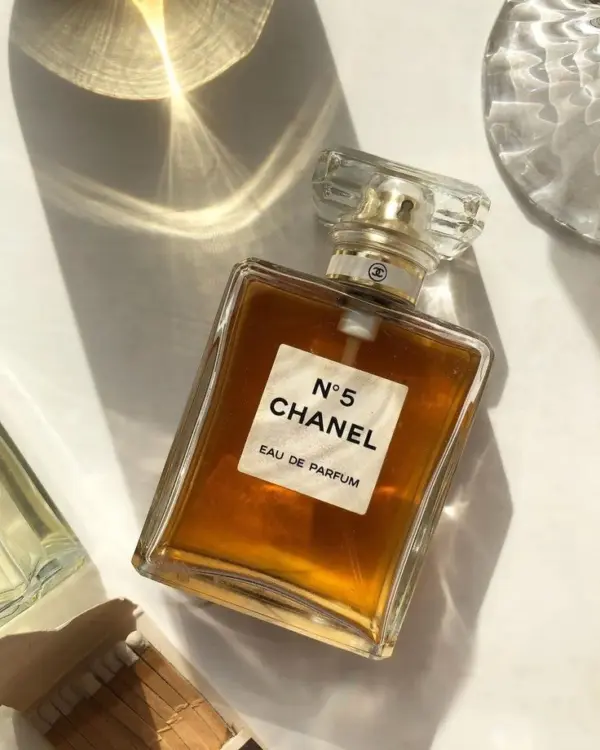
Cost-Effectiveness and Production Efficiency
Cost-effectiveness represents another significant advantage, especially in high-volume production scenarios. Crimp-on pumps typically cost less per unit than screw-on or snap-on alternatives, and the crimping process itself is relatively fast and straightforward once equipment is properly configured. For manufacturers producing hundreds of thousands or millions of units annually, these cost savings can translate into substantial bottom-line improvements.
Leak Prevention and Aesthetic Appeal
Leak prevention stands out as a critical technical advantage. The mechanical compression of crimping creates an exceptionally tight seal that resists leakage even under temperature variations, shipping stresses, or extended storage periods. This reliability reduces product loss, customer complaints, and warranty claims while ensuring consistent product performance throughout the distribution chain.
From an aesthetic perspective, crimp-on pumps offer clean, seamless appearance that appeals to premium brand positioning. The absence of visible threads or snap-fit mechanisms creates a sleek, integrated look that suggests quality and sophistication. This visual appeal can be particularly important for luxury fragrances where packaging aesthetics significantly influence purchase decisions.
Limitations and Disadvantages
However, crimp-on systems also present notable disadvantages that must be carefully considered. The irreversible nature of the attachment eliminates any possibility of reuse or pump replacement, creating both economic and environmental concerns. If a pump fails during the product’s lifecycle, the entire unit becomes unusable, potentially leading to complete product loss and customer dissatisfaction.
Limited flexibility represents another significant drawback. Once crimped, manufacturers cannot upgrade pumps, change spray characteristics, or respond to customer feedback without completely redesigning the product. This inflexibility can be problematic in dynamic markets where consumer preferences evolve or when technical improvements become available.
Environmental and Setup Considerations
Recycling challenges emerge from the permanent attachment of different materials. Separating aluminum or plastic pump components from glass bottles requires specialized processing, often making recycling economically unfeasible and environmentally problematic. As sustainability concerns grow among consumers and regulators, this limitation may become increasingly significant.
Higher initial setup costs for crimping equipment can also present barriers, particularly for smaller manufacturers or those producing limited quantities. Crimping machines represent substantial capital investments that may not be justified for low-volume production runs or startup operations with limited budgets.
Optimal Use Cases for Crimp-On Systems
The best use cases for crimp-on pumps include mass-market fragrances where cost efficiency and tamper resistance are priorities. Gift sets and promotional items benefit from the security and cost advantages, while products requiring maximum protection against counterfeiting or tampering find crimp-on systems ideal. Budget-conscious applications that prioritize initial cost savings over long-term flexibility also represent optimal scenarios for crimp-on implementation.

Screw-On Pumps: The Choice for Refillables and Sustainability
Screw-on pumps utilize threaded attachment systems that create removable, reusable connections between pump assemblies and bottle necks. This method relies on precisely manufactured threads that match between pump housing and bottle neck, creating secure attachment through mechanical thread engagement while maintaining the ability to remove and replace pumps as needed.
The technical features of screw-on systems center around threading precision and compatibility standards. Threading systems vary significantly across the industry, with different manufacturers utilizing various thread patterns, pitches, and dimensional specifications. Common thread sizes include 18mm, 20mm, and 24mm diameters, with both fine and coarse thread options available depending on application requirements and manufacturer preferences.
Torque requirements represent a critical technical consideration for screw-on pumps. Optimal tightening specifications must balance secure attachment with ease of removal, avoiding over-tightening that could damage threads or under-tightening that might allow loosening during shipping or use. Most manufacturers specify torque ranges between 8-15 inch-pounds, though exact requirements vary based on thread design, materials, and gasket specifications.
Gasket integration plays a crucial role in screw-on pump performance, providing the primary sealing mechanism that prevents leakage around the threaded connection. These gaskets, typically made from rubber, silicone, or specialized polymer materials, must maintain elasticity and sealing properties across temperature ranges, chemical exposures, and extended time periods. Gasket design and material selection significantly impact overall pump performance and longevity.
Design Variations and Material Compatibility
Design variations within screw-on systems offer flexibility for different applications and performance requirements. Standard threading follows established industry conventions, ensuring compatibility across multiple bottle suppliers and reducing inventory complexity. Fine threading provides more engagement points and potentially better sealing but requires greater manufacturing precision and may be more susceptible to cross-threading during assembly.
Coarse threading offers faster attachment and removal while being more forgiving of minor dimensional variations, making it suitable for applications where speed and ease of use are priorities. Material compatibility considerations include glass, plastic, and metal bottle necks, each presenting different challenges for thread formation, durability, and chemical compatibility.
Brand Example: Marc Jacobs Daisy Wild
Marc Jacobs Daisy Wild exemplifies the modern approach to screw-on pump implementation. The bottle comes with a screw-on pump, allowing customers to unscrew, refill, and reuse their perfume bottle with official refills. Key benefits of the screw-on system include:
Refillable Design: Users can purchase eco-friendly refills and easily maintain their bottle, reducing packaging waste substantially.
Consumer Empowerment: Should the pump wear out, customers can replace it themselves, extending the bottle’s lifespan and fostering brand loyalty.
Recycling Made Simple: Components are separable—once empty, the metal and plastic pump can be unscrewed for easier sorting and recycling.
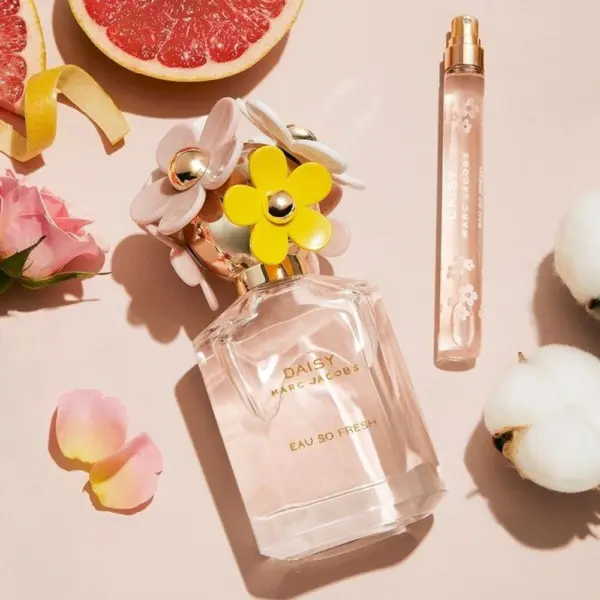
Advantages: Reusability and Environmental Benefits
The advantages of screw-on pumps begin with their exceptional reusability and serviceability. Users can easily remove and replace pumps for cleaning, repair, or upgrade purposes, extending product life and providing flexibility that other attachment methods cannot match. This capability is particularly valuable for premium fragrances where customers expect long-term usability and the option to refill or service their products.
Flexibility in pump selection and upgrades represents another significant advantage. Manufacturers can easily change pump specifications, spray characteristics, or suppliers without redesigning bottles or changing production processes. This adaptability enables rapid response to market feedback, technical improvements, or changing consumer preferences while minimizing development costs and time-to-market delays.
Environmental benefits of screw-on systems include simplified recycling processes and reduced waste generation. The ability to separate pump components from bottles facilitates proper material sorting and recycling, supporting sustainability initiatives and meeting growing environmental regulations. Refillable systems become practical with screw-on pumps, enabling circular economy approaches that appeal to environmentally conscious consumers.
Cost Considerations and Manufacturing Requirements
Lower tooling costs compared to specialized crimping equipment make screw-on systems accessible to smaller manufacturers and startups. Standard threading equipment is widely available and relatively inexpensive, reducing barriers to entry and enabling cost-effective production even at lower volumes.
However, screw-on pumps also present notable disadvantages that must be carefully evaluated. Security concerns arise from the ease of removal, which could enable tampering, counterfeiting, or unauthorized refilling. Premium brands may find this accessibility problematic, particularly in markets where product authenticity and security are critical concerns.
Potential Limitations and Quality Challenges
Potential leakage issues can develop over time as threads wear or gaskets deteriorate. Temperature cycling, chemical exposure, and mechanical stress can degrade sealing performance, leading to product loss and customer dissatisfaction. Regular maintenance may be required to maintain optimal performance, adding complexity and cost to the user experience.
Higher per-unit costs compared to crimp-on alternatives reflect the more complex manufacturing requirements and precision threading needed for reliable performance. Threading accuracy demands tight tolerances and specialized quality control processes that increase production costs, particularly when producing high-quality threads that will maintain performance over extended periods.
Threading precision requirements create additional manufacturing challenges and potential quality issues. Cross-threading during assembly, dimensional variations between suppliers, or wear during repeated use can all compromise performance and reliability. These factors require careful supplier management and quality control processes that add complexity and cost to production operations.
Optimal Applications for Screw-On Systems
Optimal applications for screw-on pumps include premium and luxury fragrances where customer experience and product longevity justify higher costs. Refillable perfume systems benefit from the removable nature of screw-on pumps, while artisanal and craft perfumers appreciate the flexibility and serviceability these systems provide. Professional and salon applications, where pumps may require frequent cleaning or replacement, represent ideal use cases for screw-on technology.

Snap-On Pumps: Innovation Meets Convenience
Snap-on pumps utilize mechanical retention systems that rely on elastic deformation and interference fits to create secure yet removable attachments between pump assemblies and bottle necks. This innovative approach combines aspects of both crimp-on security and screw-on removability, creating a middle-ground solution that addresses specific market needs while presenting unique engineering challenges.
The mechanism and design of snap-on systems center around snap-fit technology that requires precise engineering of both pump and bottle components. The snap-fit mechanism typically involves flexible tabs, rings, or collars that deform during installation and then spring back to their original shape, creating mechanical retention through interference with corresponding features on the bottle neck. This technology demands careful consideration of material properties, dimensional tolerances, and force requirements to achieve reliable performance.
Tolerance Requirements and Engineering Precision
Tolerance requirements for snap-on systems are particularly critical, as the mechanism depends on precise dimensional relationships between mating components. Too tight, and installation becomes difficult or impossible; too loose, and retention force becomes inadequate. Manufacturing tolerances typically must be maintained within 0.1-0.2mm to ensure consistent performance across production runs, requiring sophisticated quality control systems and precise manufacturing processes.
Release mechanisms vary among different snap-on designs, with some systems requiring special tools or techniques for pump removal while others can be disengaged by hand. The design challenge lies in balancing ease of legitimate removal with resistance to accidental disengagement during normal use, shipping, or handling. Some systems incorporate directional release mechanisms that require specific motions or force directions to disengage.
Engineering Considerations and Material Selection
Engineering considerations for snap-on pumps begin with plastic properties and material selection. The snap-fit mechanism relies on controlled elastic deformation, requiring materials with appropriate flexibility, fatigue resistance, and dimensional stability. Common materials include various grades of polypropylene, polyethylene, and specialized engineering plastics that maintain their properties across temperature ranges and chemical exposures.
Neck design requirements often necessitate specific bottle modifications to accommodate snap-on pumps. Unlike screw-on systems that can utilize standard threading, snap-on pumps may require proprietary neck profiles, retention grooves, or dimensional specifications that limit bottle supplier options and increase design complexity. This requirement can impact sourcing flexibility and inventory management strategies.
Brand Example: Valentino “Anatomy of Dreams”
Valentino’s “Anatomy of Dreams” exemplifies sophisticated snap-on pump implementation. The snap-on pump integrates seamlessly into the bottle design and is fixed by being pressed into place—no screwing or crimping required. Here’s why brands opt for snap-on:
Premium Innovation: The bottle achieves a luxury appearance with a secure yet user-friendly closure, catering to modern, fast-paced assembly and design trends.
Assembly Speed: Snap-on pumps dramatically cut production time and are ideal for limited-edition launches or promotional runs.
Moderate Reusability: Some snap-on designs can be removed and reattached a few times, striking a balance between classic crimp and fully-refillable screw systems.

Advantages: User-Friendliness and Production Efficiency
The advantages of snap-on pumps include exceptional user-friendliness that requires no special tools or technical knowledge for installation. The intuitive push-to-install operation appeals to consumers and simplifies assembly processes for manufacturers. This ease of use can be particularly valuable for products where customers might need to install or replace pumps themselves.
Moderate reusability represents another advantage, as snap-on pumps can typically be removed and reinstalled several times before the retention mechanism degrades. While not as infinitely reusable as screw-on systems, this capability provides some flexibility for cleaning, servicing, or pump replacement while maintaining reasonable security against casual tampering.
Cost balance positions snap-on pumps between crimp-on and screw-on alternatives, offering mid-range pricing that may suit applications where crimp-on systems lack sufficient flexibility but screw-on systems exceed budget constraints. This positioning can be attractive for manufacturers seeking compromise solutions that balance cost, performance, and functionality.
Quick assembly capabilities can significantly improve production line speeds compared to screw-on systems that require rotational assembly. The simple push-to-install operation reduces assembly time and complexity while minimizing the risk of assembly errors such as cross-threading or improper tightening.
Limitations and Performance Challenges
However, snap-on systems also present notable disadvantages that must be carefully considered. Wear susceptibility affects the retention mechanism over time, as repeated installation and removal cycles gradually degrade the snap-fit components. The flexible elements that provide retention force are subject to fatigue and dimensional changes that can compromise performance and reliability.
Limited security compared to crimp-on systems makes snap-on pumps less suitable for applications requiring maximum tamper resistance. The removable nature, while advantageous for legitimate users, also enables unauthorized access that could compromise product integrity or enable counterfeiting in premium markets.
Compatibility issues arise from the requirement for specific bottle neck designs that accommodate snap-on mechanisms. This limitation can restrict bottle supplier options, increase inventory complexity, and potentially impact design aesthetics. Manufacturers may find themselves locked into specific suppliers or forced to compromise on bottle design preferences.
Quality variability presents ongoing challenges as snap-on performance depends heavily on manufacturing precision and consistency. Dimensional variations, material property changes, or processing variations can significantly impact retention force and overall performance, requiring sophisticated quality control systems and statistical process control methods.
Ideal Applications and Market Positioning
Ideal applications for snap-on pumps include mid-range fragrance markets where cost-performance balance is critical. Travel-sized perfumes benefit from the security and ease of use that snap-on systems provide, while sample and trial products can utilize the moderate reusability for customer convenience. Seasonal or limited edition products may find snap-on systems attractive for their quick assembly and reasonable cost structure.
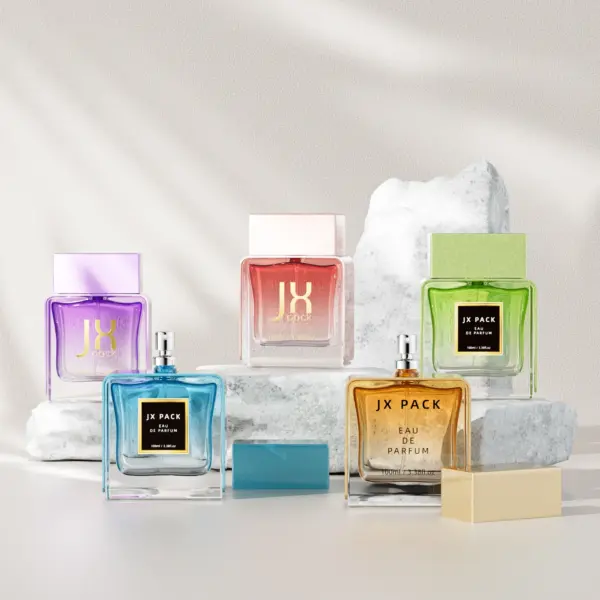
Industry Trends and Future Outlook
The fragrance packaging industry is experiencing rapid transformation driven by environmental consciousness, technological innovation, and evolving consumer expectations. Understanding these trends provides essential context for making pump selection decisions that remain relevant and competitive in dynamic market conditions.
The sustainability movement represents perhaps the most significant trend reshaping pump selection criteria and industry standards. Environmental concerns are driving both regulatory requirements and consumer preferences toward more sustainable packaging solutions that minimize waste, utilize recyclable materials, and support circular economy principles.
Eco-friendly materials development is advancing rapidly, with manufacturers introducing biodegradable plastics, recycled content materials, and bio-based alternatives to traditional petroleum-derived polymers. These materials must maintain performance characteristics while reducing environmental impact, creating new opportunities for differentiation and market positioning.
Refillable systems are experiencing unprecedented growth as consumers seek to reduce packaging waste while maintaining access to premium fragrances. This trend particularly favors screw-on pump systems that facilitate easy refilling and pump replacement, though it also drives innovation in snap-on systems designed for multiple reuse cycles.
Circular economy design principles are influencing pump development to prioritize disassembly, material separation, and component reuse. Design for disassembly concepts encourage pump systems that can be easily separated into constituent materials for recycling, while standardization efforts aim to create interchangeable components that reduce waste and inventory complexity.
Precision dosing technologies are advancing to provide more accurate and consistent fragrance delivery while minimizing waste. Micro-dosing capabilities enable extended product life and more controlled fragrance application, particularly valuable for premium and luxury markets where precision and efficiency are valued.
Consumer behavior shifts include increased environmental awareness, preference for experiential purchases, and desire for personalization that impact packaging requirements. Younger consumers particularly value sustainability and are willing to pay premiums for environmentally responsible products, while also expecting modern functionality and aesthetic appeal.
Demographic changes such as aging populations in developed markets and growing middle classes in emerging economies create different market dynamics and requirements. Older consumers may prioritize ease of use and reliability, while emerging market consumers might emphasize value and basic functionality.
Cultural preferences vary significantly across global markets, with some regions prioritizing security and tamper resistance while others value convenience and reusability. Understanding these preferences enables targeted product development and market-specific optimization strategies.
Regulatory changes continue evolving toward stricter environmental standards, safety requirements, and consumer protection measures. Extended producer responsibility regulations may require manufacturers to manage product end-of-life disposal, favoring recyclable and reusable designs. Safety standards may mandate specific materials or performance characteristics that influence pump selection.
Environmental regulations are becoming more stringent worldwide, with many jurisdictions implementing plastic waste reduction targets, recycled content requirements, and extended producer responsibility programs. These regulations may eventually mandate specific sustainability characteristics that favor certain pump types over others.
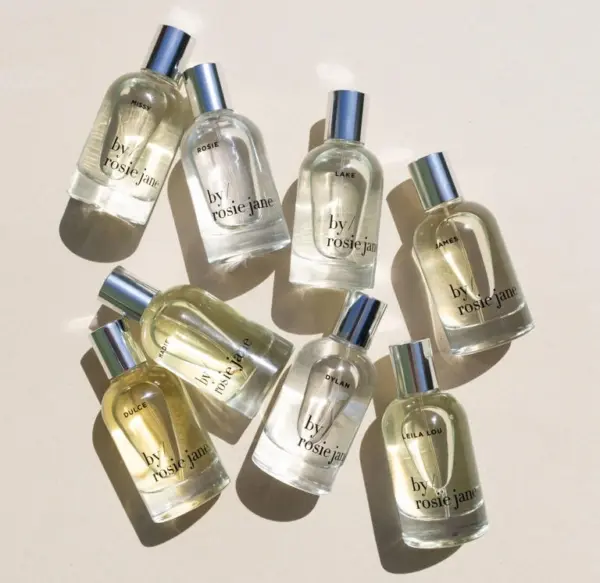
Conclusion
Selecting the right perfume pump is a strategic choice that influences every stage of your product’s life—manufacturing efficiency, overall cost, and, most importantly, how customers experience and judge your fragrance. A clear understanding of the strengths and limitations of crimp-on, screw-on, and snap-on systems lets you match the attachment method to your brand’s priorities and market positioning.
At its core, the decision balances three factors:
Security: Crimp-on pumps offer the highest tamper resistance.
Reusability: Screw-on pumps excel in refillable, sustainability-focused lines.
Cost efficiency: Snap-on pumps provide a versatile, budget-friendly middle ground.
As an experienced perfume-packaging manufacturer, Jarsking delivers not only standout bottle designs but also impeccable accessory details. From pump selection to final assembly, we ensure every component performs flawlessly and elevates your brand.
